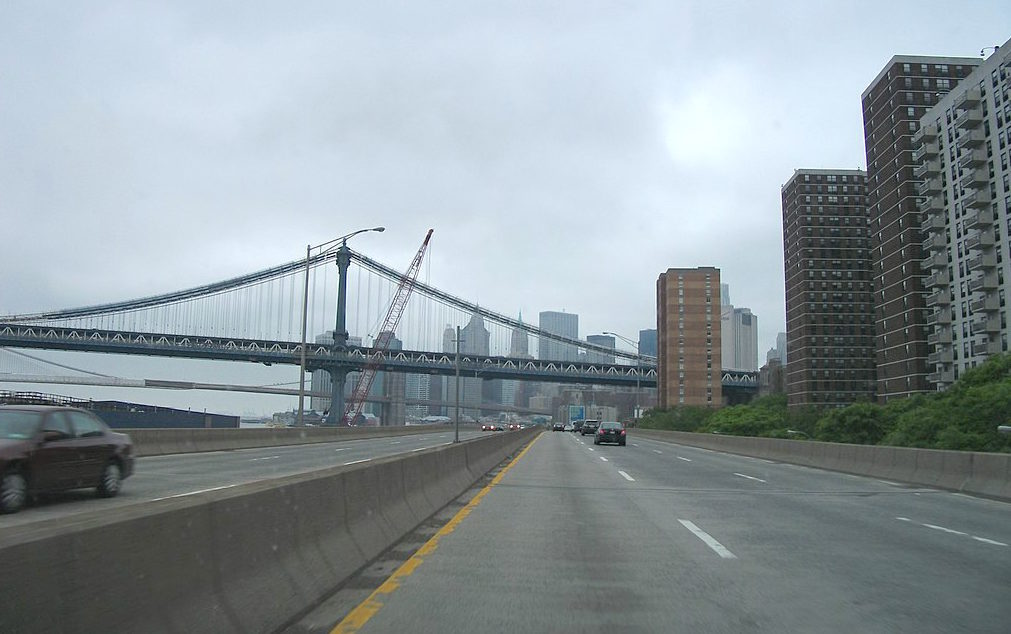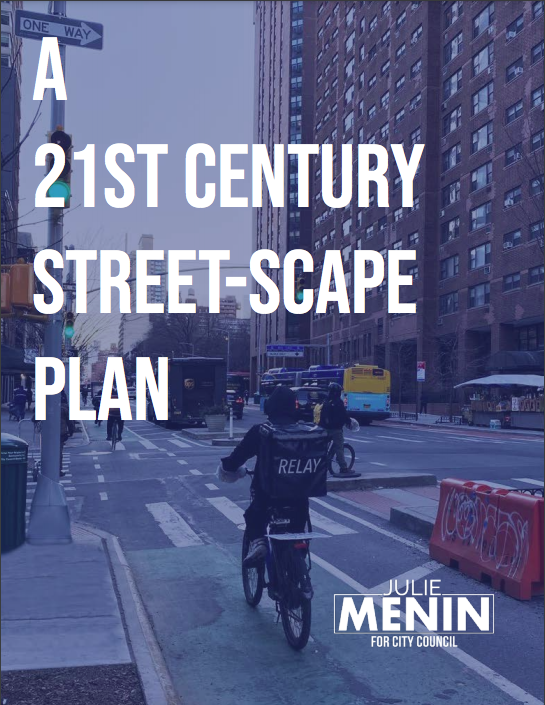And this is the establishment candidate?

City Council hopeful Julie Menin — the city's former commissioner of consumer affairs and media and entertainment — wants to expand green space on the Upper East Side by taking away space from the FDR Drive, which “severs" the district from "its greatest natural asset: the East River,” she says.
“We must explore how to reconnect the East Side with its waterfront, create space for an expanded East River Esplanade, and move New York into a new era of sustainable mobility,” she told Streetsblog. “That may take on many forms, but what is clear is that the FDR, as it exists today, must change.”
The proposal, envisioned as part of a larger effort to "re-imagine" the city's highways, comes in Menin's transportation platform, “A 21st Century Streetscape Plan,” obtained by Streetsblog. In it, Menin voices support for a raft of street-safety planks. The 10-page document, she says, “constitutes a significant rethinking of the way New Yorkers move through and interact with the built environment” that “sets the stage for a more resilient New York, better insulated from the effects of climate change, future pandemics, and a growing population.”
Menin, one of seven candidates vying for the City Council’s Fifth District on the Upper East Side, has plenty of competition on the street-safety front. Among her rivals are two outspoken advocates, lawyer Billy Freeland and journalist Kim Moscaritolo, as well as disability-rights advocate Rebecca Lamorte.
But the fact that Menin, the “establishment” candidate based on her substantial support from municipal unions and elected officials, is pushing a Transportation-Alternatives-friendly agenda shows how fully the ideas of the safe-streets movement have arrived in the mainstream.
To be sure, Menin qualifies her support for various proposals with mentions of the need to solicit “community input” — which can signal a certain obeisance to obstructionist community boards. (She served for seven years as chair of CB1, claiming credit for "helping to lead Lower Manhattan’s resurgence after 9/11.") Plus, much of the rhetoric in the document is short on details, and Streetsblog’s attempt to pin down Menin on the specifics produced some politically vague answers.
Still, Menin's platform includes:
- An expansion of open streets, by “redesign[ing] expanses of asphalt into beautiful pedestrian spaces, complete, when appropriate, with communal amenities, including playgrounds, dog runs, cafes, and more.”
- Expanded sidewalks and bump-outs in order to create “more pedestrian space, ...accessibility ...public seating, outdoor dining, plantings, bicycle parking, trash containers, public restrooms, and bus shelters.”
- Transforming “the East Side Promenade from a narrow pedestrian walkway into a park rivaling the West Side’s Riverside Park,” by “expanding both into the East River and reclaiming space from the FDR” to “build a continuous, beautiful greenway spanning the entire length of Manhattan.”
- Building “hundreds of miles of new dedicated bus lanes and create new bus lines, especially Select Bus Service lines, including on Roosevelt Island, 57th Street, Lexington Avenue, and York Avenue.”
- Expanding accessibility in the subway system and “integrating segments of the Long Island Rail Road and Metro North within city limits into the subway system.”
- Improving public transit to Roosevelt Island and “better dedicated, protected biking options to, from, and on” the island.
- Integrating the NYC Ferry, with “a single payment system and allow for free transfers between the ferries and the buses and subways.”
- Giving cyclists their own dedicated space, by increasing protected bike lanes … into a cohesive network, and, where practical, "bridges in the city should have a dedicated bike lane."
- Increasing “the amount of on-street bike parking across the city.”
- Expanding Citi Bike and integrating it into the transit system, by creating “a Citi Bike subsidy program, in the model of Fair Fares, to expand access to lower income communities. … Metrocard should include a Citi Bike membership, and free transfers should be available between Citi Bikes and the MTA.”
- A proposal to "claw back placards when there is misuse or no demonstrated need” and to create “hot-line for reporting placard abuse.”
- Reducing the number of cars on the road to decrease pollution by creating pedestrian plazas and linear parks especially in lower-income neighborhoods.
- Transferring “responsibilities for traffic enforcement out of the NYPD and into the Department of Transportation."
- Improving transit deserts by the addition of bus lines and "expanding biking infrastructure and Citi Bikes across all five boroughs.”
- Getting “the trash off streets and into dedicated containers.”
Menin would like to sound strong on biking — but, again, she nods toward the “community,” which in District 5, contains a vociferous anti-biking old guard.
“We need to create and implement a master plan for biking across the city, and within my district specifically,” she said, adding that the plan “should seek to greatly expand bike infrastructure, but be developed in collaboration with community stakeholders.”
She also declined to name any candidates for open streets in her district, instead stressing that “our district has one of the lowest proportions of green space in the city. Open Streets is the perfect catalyst for changing that. Any change, however, must be the product of a community-involved process to ensure it meets the needs of stakeholders and has grassroots support.”
Menin’s strongest claim as a street-safety advocate may be that her experience will enable her to get things done.

“As the commissioner of consumer affairs, I launched the Commuter Benefits law that incentivized workers to use public transit,” she said. “My experience from that taught me that the best way to get people out of cars is to provide an attractive alternative. I will work to significantly improve public transportation. Our buses should be speedy and frequent, and our subways should be 24/7 and reliable. I will work to make biking easier through building more protected bike lanes and bike parking. I will improve Citi Bikes by working to better integrate it into the transit system. And I will push to make our walking-based city even friendlier to pedestrians through expanding sidewalks and supporting a more ambitious Open Streets program.”
The district is now represented by the term-limited Ben Kallos, who is running for borough president.








